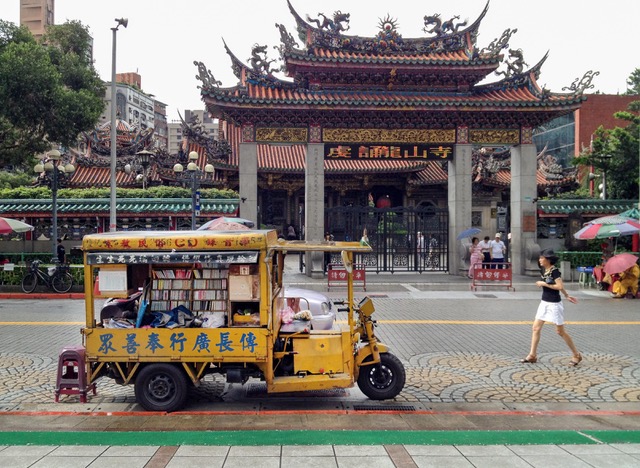
My memories of Taiwan are not visual. They are sonic. Sounds of the people, sounds of the objects, sounds of everything, coming and going, moving through spaces. Born in Taipei, I moved to Virginia with my family when I was twelve. In my adult years I’ve come to reconnect with my birthplace through listening deeply to how music and sounds make up a transitory texture in the rich, sensory tapestry of urban Taiwan. Sounds flow through towns and cities like a river.
Many things talk in Taiwan. Elevators and traffic lights project sonic messages, orchestrating movements of urban travelers. Street vendors amplify their rhythmic hawking by using megaphones with mp3 players pre-programmed to play audio advertisements on loop.
“Skirts, pants, and T-shirts! All on liquidation sale! Last day. Hurry and buy!” Sounds spill into the streets and through permeable walls of night and day markets. Scattering and smattering, these loquacious objects constitute the materiality of this unique moving architecture of sound.
People, of course, talk. They sing! Urban dwellers sing through karaoke machines set up in the streets and in open public spaces like river parks. Groups of middle-aged cyclists ride along the river while singing along to karaoke tracks projected by their personal mp3 stereos with built-in speakers. At home, enthusiasts call in on the radio to sing their favorite tunes with karaoke backing tracks to a live audience over the air.
With tarps, bamboo sticks, and amplified music equipment powered by generators, itinerant musicians shape transitory spaces for parties, relaxation, and residence, especially for the migratory urban underclass, including the elderly, war veterans, disabled, and poor. Traditionally these musicians performed at tea parlors set up along the rivers. These days you can find them at pop-up tea parlors in city parks and sometimes inside metro stations. Friends I made while doing field research told me that these ad hoc gatherings are their daytime home, a home away from home. It’s a place where they can be themselves and be happy.
Like a flâneur, I love getting lost in the streets, listening while walking, vice versa. Allowing the sounds to map my path extemporaneously, I stroll and dance through the alleys, arcades, and semi-permeable walls of outdoor markets and public parks.
About the Contributor
Wendy Hsu is a researcher, strategist, and educator who engages with research and organizing for equity in arts, technology, and civic participation. Hsu currently works as the digital strategist for the City of Los Angeles Department of Cultural Affairs. Hsu has published on a wide array of topics, from digital ethnography to open access publishing to Yoko Ono and Bollywood. Hsu is also an active performer in music projects of various genres.


